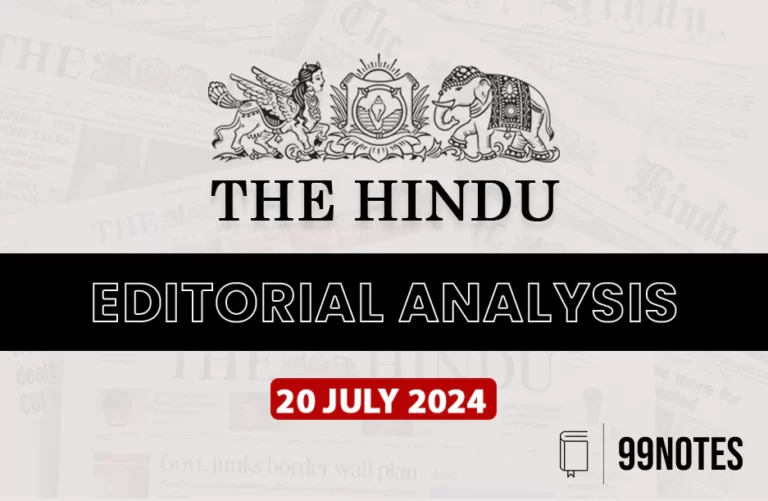6 October 2023 : The Hindu Editorial Notes PDF
The Hindu Editorial
6-October-2023
1. National unity, a three-dimensional view.
Topic: GS1 – Indian Society.
Introduction:
India’s journey towards national unity has been a complex and evolving process spanning over a century. It has been marked by political and social movements, legal frameworks, and compromise among diverse constituent groups. This unity has developed along three crucial dimensions: harmony among castes, harmony among religious communities, and a shared identity among regional diversities. These dimensions can also be labeled as Hindu unity, Hindu-Muslim unity, and heartland-periphery unity. In this article, we delve into these dimensions and their historical significance.
Hindu Unity: Gandhi’s Vision:
Mahatma Gandhi, a key figure in India’s struggle for independence, championed the cause of Hindu unity. He recognized that caste-based discrimination posed a significant obstacle to this unity, which, in turn, impeded national cohesion. However, his stance on this unity encountered challenges, notably in the form of a proposed separate electorate for the depressed classes. The Poona Pact emerged as a crucial compromise, ensuring representation for the depressed classes without a separate electorate. Reservation policies in India continue to address caste-based disadvantages within Hindu society, irrespective of conversions to other religions.
Hindu-Muslim Unity: Gandhi’s Efforts:
Gandhi was equally committed to Hindu-Muslim unity. He acknowledged Muslims as a distinct community and sought to build bridges between the two communities. Gandhi’s collaboration with the Khilafat Movement, driven by a transnational Muslim agenda, demonstrated this commitment. His efforts laid the groundwork for the acceptance of religious and cultural autonomy for minorities, a principle enshrined in the Indian Constitution.
Heartland-Periphery Unity: The Constitutional Response:
During the Constitution-making process, the need to address regional disparities became evident. Special provisions, such as Article 370 for Jammu and Kashmir and the Sixth Schedule for tribal populations in the Northeast, reflected the importance of regional harmony. Additionally, inter-State redistribution of Lok Sabha seats was temporarily suspended to maintain balance.
The Shift in Focus:
The political landscape in India has evolved, with the BJP emphasizing Hindu unity and the Hindi/Hindu heartland while sidelining Hindu-Muslim unity and regional harmony. This shift has resulted in changes in the distribution of power.
The Call for Renewed Dialogue:
In the face of these transformations, it is essential to rekindle a dynamic conversation along all three axes of national unity—caste, religion, and region. Such a dialogue should not be seen as fragmentation but rather as a unifying force in the diverse tapestry of India.
Conclusion:
India’s path to national unity has been a journey marked by historical context, compromise, and the evolving political landscape. Recognizing the significance of all three dimensions—caste, religion, and region—is crucial in reinforcing national unity as India continues to evolve in the 21st century. This dialogue should aim not at division but at achieving a more inclusive and harmonious nation for all its citizens.
2. Chemistry Nobel Prize goes to trio that made ‘artificial atoms’
Topic: GS3 – Science and technology.
Context:
- The 2023 Nobel Prize in Chemistry was awarded to three individuals for their work on quantum dots, which are tiny crystals consisting of a few thousand atoms.
More information about the Noble prize in chemistry:
- Quantum dots exhibit unique properties due to their densely packed atoms and quantum mechanics, resembling the behavior of individual atoms.
- When exposed to light, quantum dots can absorb and re-emit light at different frequencies or colors depending on their size, with smaller dots emitting bluer light.
- Quantum dots have wide-ranging applications in areas such as transistors, lasers, medical imaging, and quantum computing.
- Alexei Ekimov, Louis Brus, and Moungi Bawendi played pivotal roles in the discovery and refinement of quantum dots.
- Quantum dots, despite their complex quantum mechanical behavior, can be appreciated for their colorful and practical applications in various fields.
3. Equitable distribution of resources must not be by accentuating caste identity
Topic: GS3 – distribution of resources
Context:
- Bihar’s caste survey, similar to a census, reveals that 63% of the state’s 13 crore population belongs to the Extremely Backward Classes (EBC) and Other Backward Classes (OBC) categories.
Potential impact of Bihar’s caste census:
- The survey may have national implications, potentially boosting the demand for a country-wide caste census and challenging the 50% legal ceiling on total reservation in education and government services.
- Influential social groups may see an opportunity to advance their interests through political leverage.
- The data from the survey can provide the ‘quantifiable data’ required to justify reservation levels in various states, as demanded by the judiciary.
- Bihar’s methodology for the caste count included assigning a code to each of the 214 castes, subsuming sub-castes and sects under broader caste names.
- The Union government’s reluctance to release caste-related data from the 2011 ‘Socio-economic and Caste Census’ was due to its complexity, with respondents naming numerous castes, sub-castes, sects, clans, and surnames.
- While caste data can be valuable for specific purposes, the larger constitutional goal remains the achievement of a casteless society.
- Affirmative action addresses societal inequities, but the state must also work toward ensuring equal opportunities and equitable resource distribution without reinforcing caste identity.
4. Defusing the ticking time bomb called diabetes
Topic: GS3 – Health sector.
Context:
- A study in June 2023 conducted by the Madras Diabetes Research Foundation in collaboration with the Indian Council of Medical Research and the Union Health Ministry revealed alarming statistics about diabetes and related health issues in India.
Alarming Statistics:
- The study found that 11.4% of India’s population, roughly 10.13 crore people, are living with diabetes, and an additional 15.3% of the population, or 13.6 crore people, are pre-diabetic.
- An alarming 28.6% of the population in India is considered obese according to the Body Mass Index (BMI) measure.
Role of Ultra-Processed Foods:
- The consumption of ultra-processed foods and beverages is a significant factor contributing to the rise in diabetes and obesity rates.
- Ultra-processed foods include items like carbonated drinks, instant cereals, chips, fruit-flavored drinks, instant noodles, cookies, ice cream, bakery products, energy bars, sweetened yogurts, pizzas, processed meats, and powdered infant formulas.
- Scientific evidence links diets high in ultra-processed foods, which are often rich in sugar, fat, and salt, to an increased risk of diabetes. A 10% increase in the consumption of ultra-processed food per day is associated with a 15% higher risk of type-2 diabetes among adults.
- Ultra-processed foods often lead to overeating, weight gain, and a heightened risk of diabetes and other chronic diseases.
Consequences of Obesity and Diabetes:
- Obesity and diabetes are major risk factors for heart disease and related deaths, making the issue a public health crisis.
Marketing Strategies:
- The sale of sugar-sweetened beverages has declined in high-income countries, leading food companies to focus on low- and middle-income countries like India for expansion.
- Aggressive marketing and advertising of ultra-processed foods and beverages in India have contributed to increased consumption, especially among vulnerable populations, including children.
- The food industry’s resistance to marketing restrictions and partnerships with government programs have hindered regulatory actions.
Need for regulation:
- Advocates call for strong regulations, including defining ‘healthy food,’ implementing warning labels on unhealthy food, and restricting the promotion and marketing of unhealthy food and beverages.
- South Africa, Norway, and Mexico have recently taken similar actions to regulate food labeling and marketing, setting a precedent for India to follow suit.
A Legal Framework for Change:
- A legal framework or ordinance may be necessary to protect public health by reducing or halting the consumption of ultra-processed foods in India.
- Such a law could define healthy food, mandate warning labels on unhealthy products, and restrict marketing tactics for unhealthy food and beverages, without relying on partnerships with the food industry.
- Implementing such a law would demonstrate the government’s commitment to public health, similar to past legislation that controlled commercial baby food growth.
Conclusion:
- Addressing the health crisis associated with ultra-processed foods requires comprehensive regulatory actions and a commitment to public health, putting the well-being of the population at the forefront.
Question: What are the major health concerns associated with the consumption of ultra-processed foods, and what regulatory measures should be taken to address these concerns in India?
For Enquiry

6 October 2023 : The Hindu Editorial Notes PDF

5 Oct 2023 : Daily Quiz

5 Oct 2023 : Daily Answer Writing

5 Oct 2023 : Indian Express

5 Oct 2023 : PIB

5 October 2023 : Daily Current Affair

5 October 2023 : The Hindu Editorial Notes PDF

Directive Principles of the State Policy (DPSPs)

4 Oct 2023 : Daily Quiz

4 Oct 2023 : Daily Answer Writing
October 2023 The Hindu 6 October 2023 : The Hindu Editorial Notes PDF The Hindu Editorial
5-October-2023
1. Retribution for the south, accolade for the north.
Topic: GS2 –…
Daily Quiz 5 Oct 2023 : Daily Quiz 5 Oct 2023 : Daily Quiz…
mains answer writing 5 Oct 2023 : Daily Answer Writing Mains Answer Writing
5-october-2023
Q1) The first step to eradicating poverty is reliable poverty assessment…
Indian Express 5 Oct 2023 : Indian Express Indian Express
5-October-2023
1) Cauvery Water Dispute
Context:
The Cauvery Dispute has flared up…
October 2023 PIB 5 Oct 2023 : PIB PRESS INFORMATION BUREAU
5-Oct -2023
1. Cabinet approved Amendment to the Central Universities Act,…
Daily Current Affairs 5 October 2023 : Daily Current Affair Daily Current Affairs
5-October-2023
1. Seven dead as glacial lake bursts in Sikkim.
Topic: GS3 –…
October 2023 The Hindu 5 October 2023 : The Hindu Editorial Notes PDF The Hindu Editorial
5-October-2023
1. Retribution for the south, accolade for the north.
Topic: GS2…
Polity Directive Principles of the State Policy (DPSPs) Part IV (Articles 36 to 51) of the Constitution constitutes the Directive Principles of State Policy(DPSPs)….
Daily Quiz 4 Oct 2023 : Daily Quiz 4 Oct 2023 : Daily Quiz…
mains answer writing 4 Oct 2023 : Daily Answer Writing Mains Answer Writing
4-october-2023
Q1. Civil society organizations, play a pivotal role in fostering…



